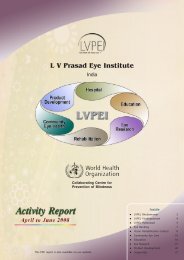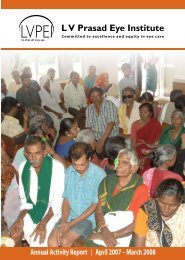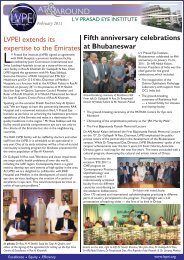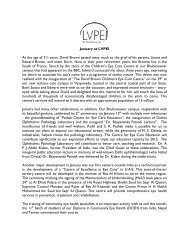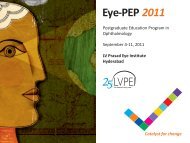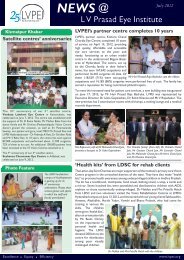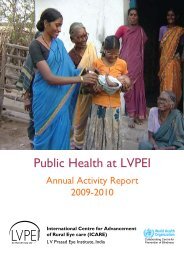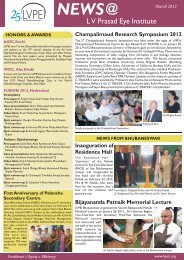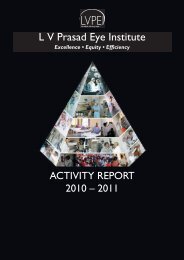Understanding Glaucoma - LV Prasad Eye Institute
Understanding Glaucoma - LV Prasad Eye Institute
Understanding Glaucoma - LV Prasad Eye Institute
You also want an ePaper? Increase the reach of your titles
YUMPU automatically turns print PDFs into web optimized ePapers that Google loves.
eyes, but usually unequally, as a result the better eye keeps 'filling-in' for the eye that is affected more.Due to extreme constriction of side vision, tunneling of vision occurs. Central vision continues to remainrelatively good till the very last stage. That is why, early on in the disease, patients fail to realize thatthey have a problem.What are the different types of glaucoma?Based on the status of the drainage of the fluid (aqueous), responsible for high pressure, out of the eye,glaucoma can be divided into two main categories, "open angle" and "closed angle" (or "angle closure")glaucoma. The acute variety of angle closure can appear suddenly and is often painful; visual loss canprogress quickly, but fortunately the discomfort often leads patients to seek medical attention earlybefore permanent damage occurs. However the vast majority suffer from chronic glaucoma, which canbe both open angle and angle closure. This tends to occur with advancing age and progresses at a slowerrate so patients may not notice they have lost vision until the disease has advanced significantly.However glaucoma can also be consequent upon other eye diseases (secondary glaucoma) and can alsobe present at or around birth (congenital glaucoma); thus age is no bar as far as development ofglaucoma is concerned.Is there any way one can prevent blindness in glaucoma?<strong>Glaucoma</strong> is a blinding disease, but blindness can be prevented if it is detected early. It is recommendedthat all individuals above the age of 35 have eye examination, including recording of eye pressure(tonometry) and examination of the optic nerve head (fundoscopy) , every 2 years. If there is a suspicionof glaucoma, then gonioscopy (viewing of the drainage angle) and visual field test (Perimetry to checkfor side vision) is done. Imaging (scans) may also be done, especially when there is suspicion of earlydisease.What are the risk factors of glaucoma?<strong>Glaucoma</strong> is 4-10 times more common in blood relations of patients diagnosed with glaucoma. Otherthan family history, increasing age (above 35 years), high degree of short-sightedness (myopia) andusage of any type of steroid medication (eye drops, inhalers, tablets, ointments etc) are all risk factors.In some parts of India, angle closure disease is quite common.Can glaucoma be cured?<strong>Glaucoma</strong> affects the nerve and hence the ensuing damage is permanent. There is no cure, but we cancertainly control it and help prevent any further loss of vision.How is glaucoma treated?Current treatment of glaucoma is directed towards control of eye pressure by means of eye drops(sometimes tablets for short duration), laser and glaucoma surgery.



